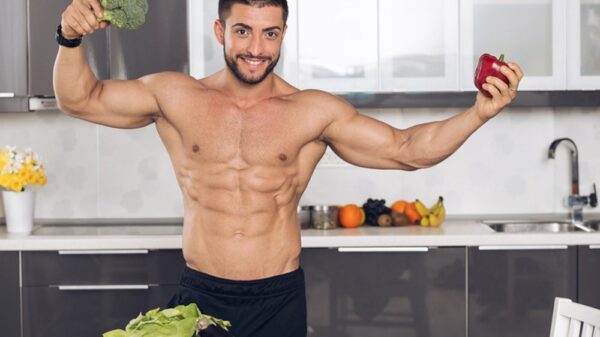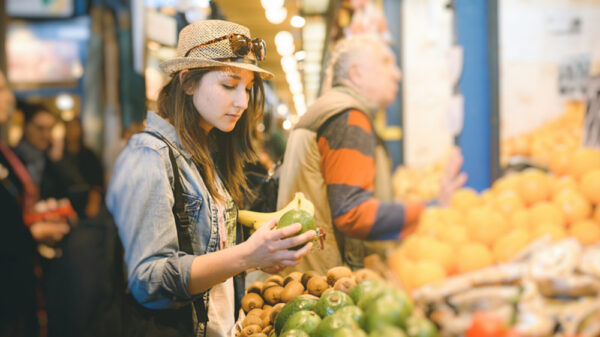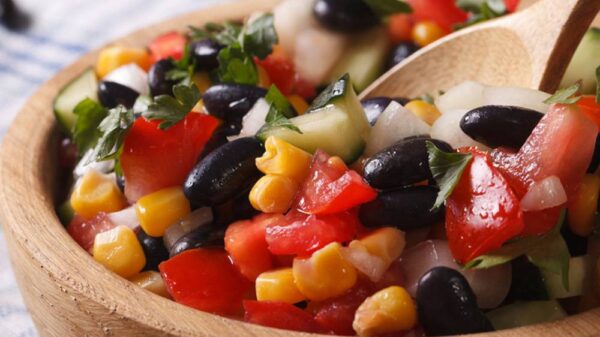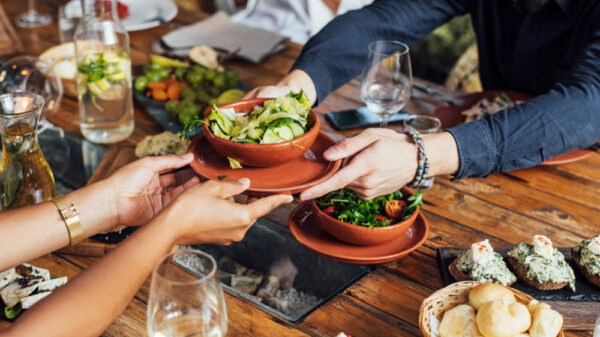If you’re deciding to switch to a primarily plant-based diet for fatty liver disease, this means that nearly all of your pantry staples will need to be replaced. When transitioning to a plant-based diet, it can be difficult to know how to make vegan meals that are both tasty and healthy. Here we give you the step-by-step guide to equipping your kitchen with vegan staples and making easy vegan meals for beginners.
Tips and Hacks for Following the Plant-Based Diet for Beginners
The most challenging part of the plant-based diet is changing all of your staple foods and getting accustomed to new ingredients. Here are helpful tips for creating easy, healthy, plant-based meals.
1. Keep Your Entire Spice Rack
Getting rid of meat and dairy doesn’t mean you have to sacrifice your favorite flavors! Most seasonings and spices are plant-based. Plus, as an added bonus, lots of spices even afford the added benefits of antioxidants and polyphenols which help your liver heal from inflammation.
2. Make One-to-One Substitutes
Going plant-based doesn’t mean changing everything, sometimes it just means making some swaps that only create small changes in taste or texture. For example, plant-based milks can be substituted for dairy milk in nearly all recipes.
3. Stick to Whole Foods
Aim to eat primarily whole foods like fruits, vegetables, nuts, seeds, and beans. Below we explore vegan meal ideas – you’ll be surprised how many tasty, easy meal options there are when using whole foods! Whole foods contain macronutrients and micronutrients that you’re body needs for optimal functioning and to protect against diseases like diabetes, insulin resistance, cardiovascular disease, and fatty liver disease.
4. Eat More Food
This is a big one. One of the most significant reasons for people to give up on the plant-based diet comprised of whole foods is because they get hungry more often. Fruits, vegetables, and whole grains are not as calorie-dense as meat, cheese, yogurt, and eggs. The volume of food you must eat to meet your body’s calorie demands is much higher. Know that eating larger quantities of whole foods is normal. Give your stomach and digestive system time to adjust to the extra fiber and volume. You may feel bloated for a period of time, but after a few weeks, your digestive health will actually be better than before you began a plant-based diet.
5. Skip Processed Foods
Manufacturing vegan foods is a big business, and there are countless cakes, cookies, breads, ice cream, vegan “cheese,” vegan “sausages,” and other products that are meatless versions of classic comfort foods. Steer clear of these processed products that are marketed as “vegan.” Vegan packaged foods are often filled with refined flours and added sugars, just like non-vegan packaged foods. These ingredients – whether they’re paired with animal products or not – will contribute to a variety of diseases. In addition to the refined carbs and added sugar, these can contain high levels of sodium and preservatives that are detrimental to metabolic health, raise your blood pressure, and contribute to fatty liver disease. Save vegan treats for the occasional splurge.
6. Buy in Bulk
A common misconception is that eating vegan means you have to break the bank. This is not the case! In fact, eating vegan can mean saving money, especially when you buy in bulk. Good items to buy in large quantities are those that are nonperishable, stored in the freezer, or take a long time to go bad. For example, the best foods to buy in bulk include plant-based milk, brown rice, whole-grain pasta, canned and dried beans, spices and seasoning, bananas, frozen fruits, and frozen vegetables.
7. Pre-Chop Vegetables
Vegan meals are not more complicated than non-vegan meals – they can just be time-consuming due to the large amount of chopping involved. When possible, try to pre-chop any vegetables that you may use that week for dinners and lunches. This includes kale, romaine lettuce, peppers, and any other vegetables you like to use. This makes it easier to just throw together ingredients for a quick meal.
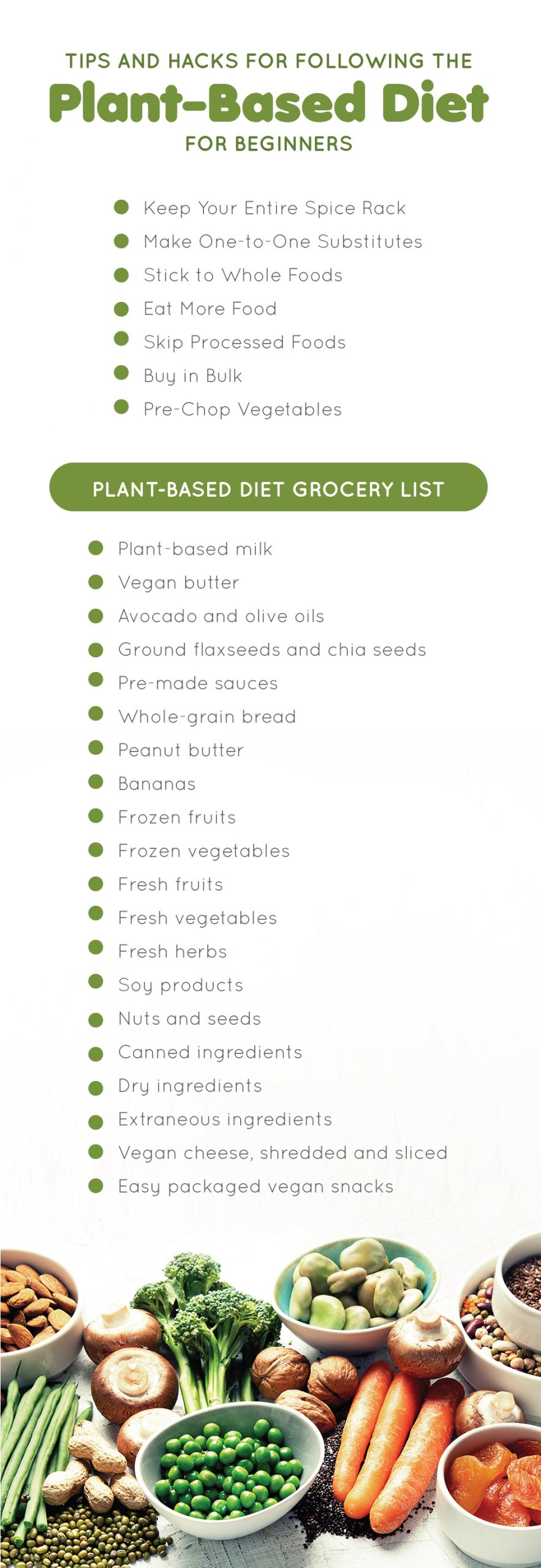
Plant-Based Diet Grocery List
We’ve formulated this vegan food list based on the ingredients you’ll use for the easiest vegan meals. Keep this list on your phone, and when you notice some getting low, simply make a note next to the ingredient on the list.
- Almond milk: Plant-based milks can last months at room temperature when sealed. Choose your favorite plant-based milk and buy several containers at a time. In addition to almond milk, some great options are soy, cashew, and nonfat coconut milk. Plant-based milks work great as substitutes for breakfast cereal, oatmeal, smoothies, and coffee creamer.
- Vegan butter: There are numerous vegetable-based butters that taste just like the dairy-based butter you love.
- Avocado and olive oils: When cooking in high heat, use a little bit of avocado oil since the fatty acid structure of avocado fat can withstand high temperatures more easily than olive oil.
- Ground flaxseeds and chia seeds: These can be bought in large bags and can be inconspicuously added to baking recipes, breakfast cereal, and stews for extra protein, fiber, and antioxidants.
- Pre-made sauces: Though it’s possible to make sauces on your own, having pre-made vegan sauces on hand is super helpful when you’re in a pinch and need to add flavor to food. Look for dairy-free, vegan versions of curry sauce, hot sauce, salsa, tahini, Thai peanut sauce, barbeque sauce, pesto, and any other of your family’s favorites.
- Whole-grain bread: Look for bread that contains whole grains, nuts, and seeds, and no added sugar.
- Peanut butter: This household favorite is naturally vegan and is likely in your pantry already.
- Bananas: These should be bought in bulk – don’t worry if bananas turn brown. Overripe bananas store well in the freezer and are excellent sweeteners for smoothies.
- Frozen fruits: Blueberries, raspberries, and strawberries last a long time in the freezer and can be added to smoothies or defrosted to use as breakfast toppings.
- Frozen vegetables: Contrary to popular belief, frozen veggies retain their nutrients. Having packages of frozen veggies in the freezer can be a life-saver when you’re running low on fresh ingredients. Look for frozen spinach, peas, corn, carrots, broccoli, and cauliflower.
- Fresh fruits: Your grocery list should include fresh fruits like apples, oranges, avocados, spaghetti squash, tomatoes.
- Fresh vegetables: Great vegetables for your grocery list include spinach, kale, romaine lettuce, purple cabbage, onions, garlic, sweet potatoes, bell peppers, broccoli, snow peas, and carrots.
- Fresh herbs: Cilantro and basil are must-haves when it comes to fresh herbs.
- Soy products: Soy products provide lots of protein in the absence of meat and dairy products. Tofu and tempeh work well as meat substitutes.
- Nuts and seeds: These provide healthy fats and work well as salad- toppers and in trail mix.
- Canned ingredients: Black beans, chickpeas, kidney beans, white beans, tomatoes, and jackfruit
- Dry ingredients: Lentils, brown rice, quinoa, millet, and oats are excellent nutrient-packed foods to have on hand.
- Extraneous ingredients: Pickles, olives, marinated mushrooms, and sun-dried tomatoes, are delicious add-ons for salads and quick pasta dishes.
- Vegan cheese, shredded and sliced: Though vegan cheese substitutes are processed and should be used sparingly, having some on hand can be helpful for cooking up vegan versions of your favorite comfort foods when you have the hankering for them.
- Easy packaged snacks: Though these should be eaten in moderation, vegan packaged snacks are crucial to staving off hunger without caving into temptations for fast foods. A high-protein snack is important for soothing hunger pains. Look for plant-based protein bars that are sweetened with natural ingredients like dates and erythritol. Steer clear of packaged foods that contain added sugars, refined flours, and artificial ingredients.
Easiest Vegan Meals
Vegan meals don’t have to be difficult to make! Sometimes it just takes a little extra planning. We’ve formulated some of the easiest vegan meals that are inspired by some classic mealtime favorites. Remember, just because you are avoiding animal products doesn’t mean you have to sacrifice your favorite flavors!
Vegan Breakfast Recipe Ideas
Just because your breakfast is plant-based, this doesn’t mean it should leave you feeling hungry and unsatisfied. Vegan breakfasts can be hearty and filling while providing a nutritious kick to start your day.
- Oatmeal: This breakfast classic is also completely vegan and very healthy. If you prefer your oatmeal hot, mix ground chia seeds, ground flax seeds, and cinnamon into your cooked oats in the morning. Top with sliced bananas, blueberries, a scoop of coconut cream, and a drizzle of maple syrup.
- Breakfast smoothies: For the quickest breakfast on-the-go, smoothies are a great option. These should be packed with protein to fuel your day. Break up two frozen bananas into chunks and add to blender. Add 1/2 cup of blueberries, strawberries, or raspberries for antioxidants, a tablespoon of peanut butter, and a scoop of your favorite plant-based protein powder. An amino acid supplement that provides optimal ratios of essential amino acids is also an excellent addition to a breakfast shake. Add 1 cup of your favorite plant-based milk for a shake with a thick consistency and add more milk if you prefer a thinner consistency.
Vegan Lunch Recipe Ideas
- Veggie Bowl: “Bowls” are an upgrade on lunchtime salads, and they’re super easy to make and take with you to work. Use chopped kale and romaine lettuce as the base of your bowl. On top, add a serving of whole-grains, like brown rice or quinoa, for fiber, protein, and vitamins. Sprinkle in your favorite nuts or seeds like walnuts or pumpkin seeds. Add a serving of white beans, sundried tomatoes, chopped purple cabbage, chopped basil, and avocado slices. Bring along a small container of oil-free dressing.
- Burrito Bowl: The burrito bowl is a spin on the veggie bowl and is just as tasty and portable. As a base, use chopped kale and romaine lettuce. Add black beans, smoked tofu, brown rice, canned corn, chopped tomatoes, chopped onions, chopped peppers, and cilantro. Top with salsa, hot sauce, and avocado-based dressing.
- Vegan Grilled Cheese: A vegan grilled cheese is a splurge that tastes almost like the real thing. All you need for this are two slices of whole-grain bread, a vegan butter substitute, and vegan cheese. Layer cheese between the two slices of bread and coat the outside of the bread in a thin layer of vegan butter spread. Heat in a pan until the outside of the sandwich is crispy and the cheese is melted.
Vegan Dinner Recipe Ideas
Plant-based, weeknight dinners can still be savory and flavorful without meat and dairy.
- Burritos: Burritos will satisfy your craving for Mexican food, and you won’t even miss the meat! As a meat substitute, combine black beans, cubed sweet potato, and cubed tofu. You can mash these three ingredients until it reaches the consistency of ground beef, or you can simply leave the ingredients intact. Season using a can of tomato paste, cumin, paprika, salt, and pepper. In a pinch, use a packet of your favorite vegan taco, fajita, or burrito seasoning. If you like, cook some brown rice to add to your burrito wrap. As an extra veggie filling, sauté red peppers, green peppers, onion, and garlic in a pan and season with cumin, paprika, salt, and pepper. As a topping, create a quick version of guacamole by mashing avocados with lime juice and cilantro. For a quick, make-shift crema, blend cashews in a blender with coconut cream until desired consistency is reached. Now it’s time to assemble your burritos. Choose whole-wheat tortillas or grain-free tortillas. Layer with brown rice, seasoned “meat,” peppers, and onions. Top with avocado, crema, hot sauce, and salsa. Roll into a burrito and enjoy!
- Thai Stir-Fry: Thai food is often naturally vegan since Thai cuisine tends to incorporate lots of coconut milk instead of dairy-based cream. For the base of your stir-fry, cook tofu or tempeh in a little oil until crispy. Add any variety of veggies of your choice, like sliced carrots, zucchini, snow peas, red peppers, mushrooms, and cauliflower. Sauté until vegetables have softened. To make your own sauce, use light coconut milk, lemongrass, garlic, chili, ginger, salt, and pepper. Another sauce option is making a curry sauce using light coconut milk, curry powder, ginger, salt, and pepper. Add extra turmeric to the sauce for an extra punch of antioxidants.
- Pasta Bolognese: For the “meat,” mash white beans and tofu to create the consistency of ground beef. Sauté with garlic and onions and season with salt, pepper, basil, red pepper flakes, and oregano. Add your favorite tomato sauce and mix with the meat substitute until well-combined. For pasta, you can use whole-grain wheat, spelt, or buckwheat pasta. Lentil pasta and chickpea pasta are also available and both provide more protein than regular whole-wheat pasta. To pack even more veggies into this meal, try using zucchini noodles instead of pasta. You can buy pre-spiralized “zoodles” at the grocery store, or spiralize them yourself. Spaghetti squash is another option for replacing pasta with nutrient-packed, lower-calorie vegetables.
- Lentil stew: Vegan lentil stews are excellent options for vegan meals because they can be prepared in massive quantities and keep in the fridge for up to a week. Leftovers can even be frozen and pulled out when you need a quick, nutritious dinner. There are countless ways to season and prepare vegan lentil stews. Lentil stews are hearty and delicious when paired with lots of vegetables. First, sauté onions, leeks, and garlic. Add chopped mushrooms, chopped sweet potatoes, chopped fennel, canned tomatoes, and chopped carrots. Add vegetable broth and season with cumin, turmeric, chili powder, salt, pepper, and a couple bay leaves. Then choose the type of lentils you want to use. Green or brown lentils usually retain their shape when cooked, while red lentils disintegrate. Both options are nutrient-packed and tasty, it just depends on what texture you prefer. Cook all of the ingredients together until the sweet potatoes and lentils are cooked. Serve over quinoa, brown rice, or whole-grain pasta. Top with a squeeze of lemon juice and chopped cilantro. Enjoy!
- Jackfruit pulled “pork:” Jackfruit pulled “pork” may almost fool you into thinking it’s really pork. Jackfruit is an excellent substitute for shredded meat, making it perfect for barbeque pulled pork recipes. Remove jackfruit from the can and shred in a pan until it resembles pulled pork. Cook until it softens and use your favorite barbeque sauce to season it. As a side, you can prepare a vegan mac-and-cheese using whole-wheat pasta, almond milk, and vegan cheese. To hide extra vegetables in the mac-and-cheese, simply steam cauliflower, chop into small pieces, and fold into the pasta and cheese mixture. Serve the barbeque pulled “pork” with a side of vegan mac-and-cheese. Enjoy!
Snacks
- Trail mix: Combine pecans, walnuts, dried cherries, and vegan chocolate chips for a snack that provides healthy fats and antioxidants.
- Hummus and sliced vegetables: You can whip up hummus in minutes by throwing chickpeas, a drizzle of tahini, salt, pepper, garlic, and olive oil into a blender. Serve with carrots, celery, tomatoes, and any other veggies you like for dipping.
- Apples with peanut butter: This classic combo may not be novel, but it’s satisfying and contains the perfect balance of carbs and protein. Plus, it’s tasty, with a complementary blend of sweet and salty.

Conclusion
When planned out, a plant-based diet is healthy for preventing and reversing conditions like metabolic syndrome and fatty liver disease. When going plant-based, it can be tricky to know where to start. The tips and meal ideas above should help kickstart your vegan journey. Splurge meals are included because the plant-based diet shouldn’t feel like a punishment or deprivation. Instead, it should feel like a fun, flavorful way to eat liver-friendly foods.
Don’t be afraid to experiment with different flavors and combinations of ingredients – fantastic vegan recipes are born through trial and error. A vegan diet can be just as satisfying – and a million times more healthy- than a diet that contains mainly animal products.

